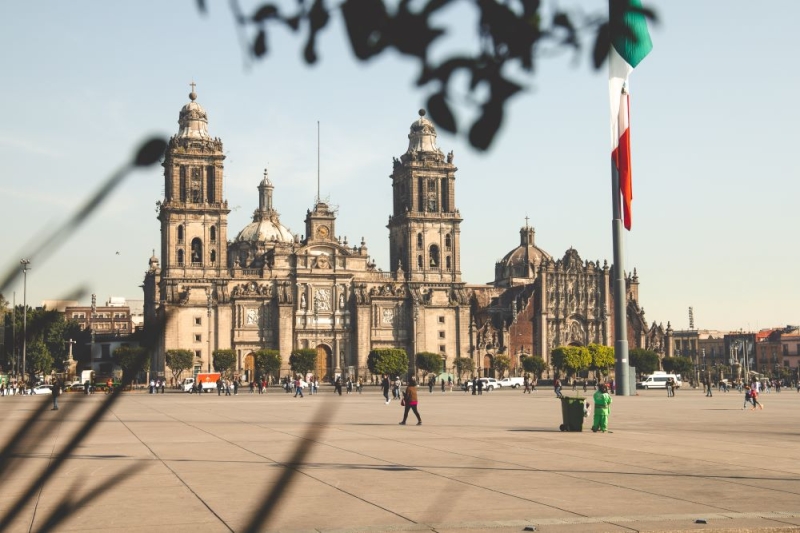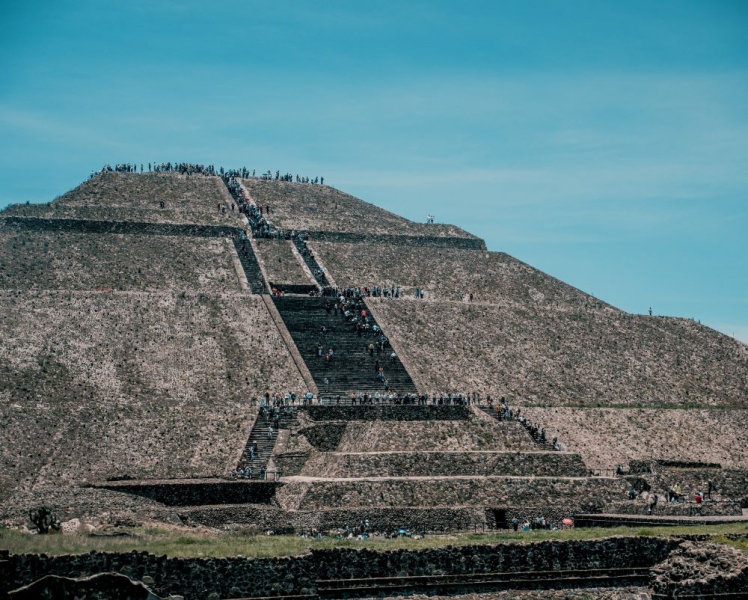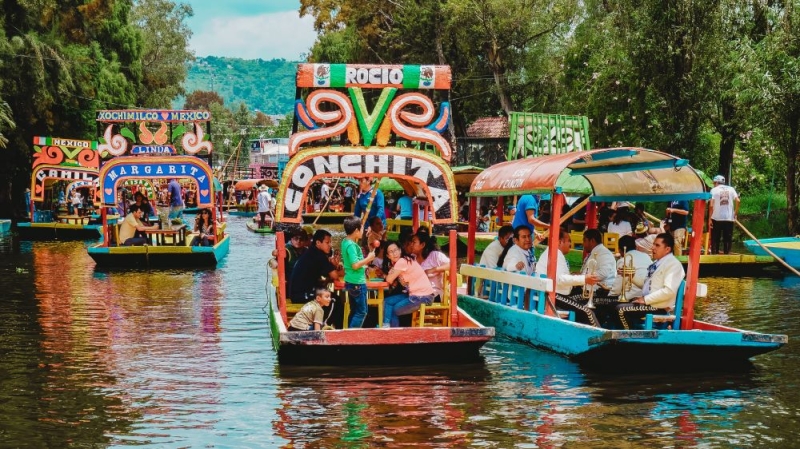
The capital of Mexico is a huge anthill with a labyrinth of streets that harmoniously combine the majestic architecture of the colonial era and the heritage of the Mayan and Aztec tribes. Here, taco joints coexist with fashionable hotels, and organ grinders and mariachis roam the center. In Mexico City, everyone will find something to enrich their leisure time.
How to get there

By air only. The most convenient way is with a transfer in Istanbul – tickets for a Turkish Airlines flight will cost from 70,000 rubles* round-trip. You will spend 12 hours on the road. The connection in Amsterdam with KLM will take a little longer – from 19 hours, the price will be similar – from 70,000 rubles* round trip per person.
From Terminal No. 1 it is convenient and quick to get to the city center:
- In 25 minutes by metro: the airport station on the yellow line is called Terminal Aérea. Travel cost – 5 pesos* (30 rubles).
- In 45 minutes by bus number 4 of the MetroBus company: you need to get to Plaza Santo Domingo. Ticket costs 30 pesos* (120 rubles).
- By taxi for 250-300 pesos* (900-1100 rubles) or by Uber for 130-200 pesos* (470-720 rubles).
Entry conditions during quarantine
On the Mexico Migration Service website you will need to obtain an electronic entry permit (Acrobat Reader required). It’s free and valid for 180 days. If you have Schengen, then permission is not required. Another good news: a coronavirus test is also not needed.
Where to stay

There are thousands of accommodation options, prices start from 450 rubles* per night. It all depends on your budget and desired comfort.
Recommended from hotels:
Hotel Catalina (from 1600 rubles* per night per person)
Fiesta Inn Centro Historico (from 2800 rubles* per night per person)
There are also apartments with kitchen:
Departamentos Pánuco (from 3100 rubles* per night per person)
Monoambientes Cuauhtemoc (from 2500 rubles* per night per person)
And guest houses:
Habitaciones Monterrey (from 1100 rubles* per night per person)
Things to do
Day one

Palace of Fine Arts
It is simply necessary to devote it to exploring the city center, especially since many attractions are located within walking distance of each other.
Let’s start the route from the busiest square, the Zocalo, where the National Palace is located – the residence of the president with beautiful wall frescoes inside, reflecting the history of the country. On the same square stands the Cathedral, the main treasure of which is the Altar of the Kings. Admission is free.
We look into the sweet paradise of Pastelería Ideal and try local desserts, for example, Tres leches cake or custard Flan from 35 pesos* (130 rubles).
Then the route goes through the Palace of Fine Arts, which now functions as an opera and museum. Famous Italian, Spanish and Mexican artists and architects participated in its creation. It’s worth a visit to appreciate the frescoes and Tiffany curtain. Entrance ticket costs 70 pesos* (260 rubles).
We reach the Sonora market. Unrequited love, financial problems or malaise – at the largest market of esoteric goods there is a solution for everything in the form of roots, potions, soap and other strange substances and amulets.
Check out Cafebrería El Péndulo – this is a whole museum forest with a fancy design, where thousands of books, CDs, vinyl, and souvenirs are presented. You can also drink coffee here.
Towards evening we head to Piazza Garibaldi – here it is, the Museum of Tequila and Mezcal. We taste it and buy something to take home. The entrance ticket costs 75 pesos* (280 rubles). In the evening, groups of national singers and mariachi musicians flock to the square and perform their favorite songs for a fee. We settle down at a table in one of the cafes and merge with the Mexican culture.
Day two

Archaeological complex of Teotihuacan
Mexico is not only tequila and quesadillas. This is the legacy of the Mayans and Aztecs, who left traces of their civilizations throughout the country.
We go to the Teotihuacan archaeological complex. We explore the vast territory of the former “City of the Gods”, suddenly abandoned by all the inhabitants, look into the museum with artifacts, and marvel at the Pyramid of the Sun – one of the largest in the country. From the top there is an unparalleled view of the mountains.
How to get there. Buses depart from Autobuses del Norte Station from exit no. 8 and go to Peramides station. The cost of a round-trip ticket is 104 pesos* (380 rubles).
Entrance cost to the complex is 80 pesos* (300 rubles), price for a guided tour – from 700 pesos* (2,600 rubles).
Day three

Xochimilco
Floating Gardens, Mexican Venice – the charming district of Xochimilco is called for its canals. People come here for a romantic boat ride. You will be taken along small canals past the Island of the Dolls. Rumor has it that once a man began collecting discarded “beauties”, and then settled with them on the island. Another legend says that the ghost of a drowned girl wanders here.
Boats will float by with vendors offering their wares, from souvenirs and flowers grown here to snacks, michelada (beer with lime and a hot and sour sprinkle) and pulque (a low-alcohol drink made from the juice of fermented agave). There are mariachis floating on separate trachineras, who are ready to jump on you and perform any composition. The cost of the boat is from 500 pesos* (1,800 rubles) per hour of skiing.
After a walk you will definitely be hungry, so you can stop by market and try tacos and tostadas with different fillings.
Day Four


It’s time to get acquainted with the picturesque art quarter of the capital – let’s go to Coyoacan. We reach the pretty blue building in which Frida Kahlo lived and worked with her husband, artist Diego Rivera. Now it is a museum with works of geniuses of the fine arts with a preserved creative environment in which every detail matters. Entrance fee: 230 pesos* (830 rubles).
Literally a few steps away is the house-museum of Leon Trotsky, in which he was assassinated. Now here you can see the works of Lenin’s ally, important documents, and newspaper clippings. The entrance ticket costs 70 pesos* (250 rubles). By the way, Trotsky was credited with an affair with the artist. Ah, these Mexican passions!
Walk along Francisco Sosa Street and admire the remaining masterpieces of the colonial era.
For souvenirs, head to the Artesanal market. Your eyes will be dazzled by all the decorated guitars, costume jewelry, national fabrics, ceramics and figurines of the goddess of death Santa Muerte.
Look into the Church of San Juan Bautista, admire the decoration and feel the peaceful atmosphere of one of the most beautiful churches in the city. Pass by the Coyote Fountain on your way to the Viveros de Coyoacan Nursery Park. A real oasis with diverse fauna, landscape, runners and squirrels. Be careful, the squirrels here are wild and can attack.
You can have a snack on tacos and enchiladas, taste cheeses and local sweets at the Coyoacan market.
Day five

Soumaya Museum of Contemporary Art
Let’s be honest: shopping is an indispensable part of the tourist program. And we are talking not only about bazaars and markets with their plates and trinkets, but also about malls. We suggest taking a break from cultural affairs and going shopping, especially since the main centers with world brands and lesser-known Latin American brands are concentrated in one area of Polanco: Antara Fashion Hall, Miyana, Pabellon Polanco, Plaza Carso.
We take a break between shopping at the Soumaya Museum of Contemporary Art. The building, shaped like an anvil, was built at the expense of one of the richest people in the world, Carlos Slim. Here you can see 66,000 objects of art from Central America and Europe from his personal collection. Admission is free.
Day six

Chapultepec Palace
It is worth setting aside special time to explore Chapultepec Park: go to the zoo and Botanical Garden, stroll along the green alleys, sit by the fountains, and ride a catamaran on the lake. Then climb the hill to the castle of the same name, once the former residence of the governor, to see the rich decorations and collection of carriages. The park also houses one of the main cultural attractions of the city – the National Museum of Anthropology. The original Mayan calendar and other relics of ancient civilizations are kept here. During the pandemic, the exhibition may be closed, then go see the works of local artists at the Museum of Modern Art.
*Prices valid at time of publication

